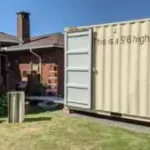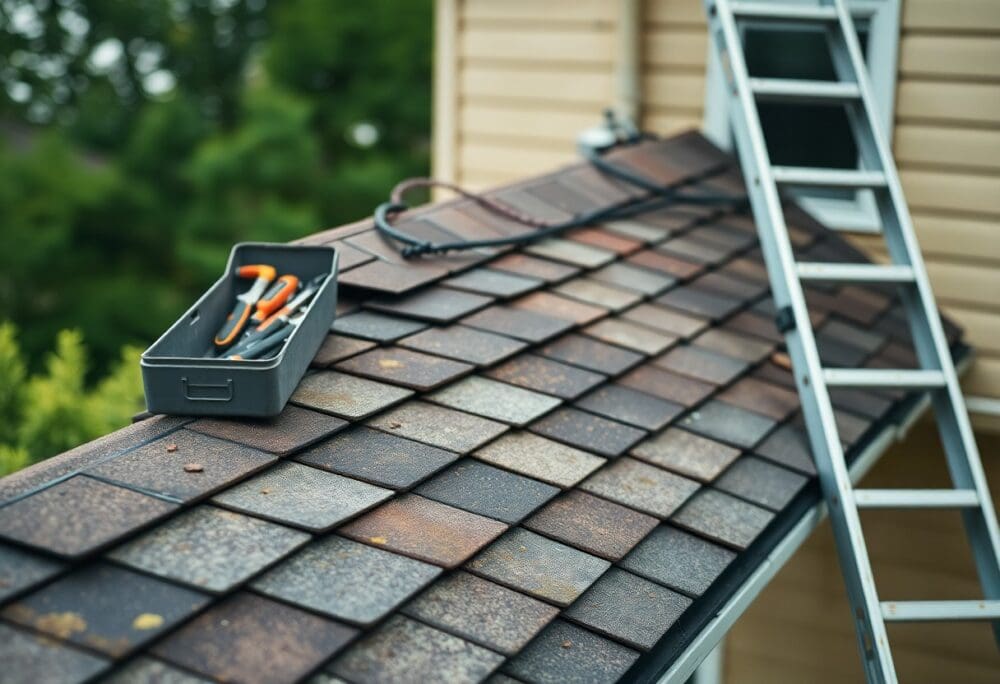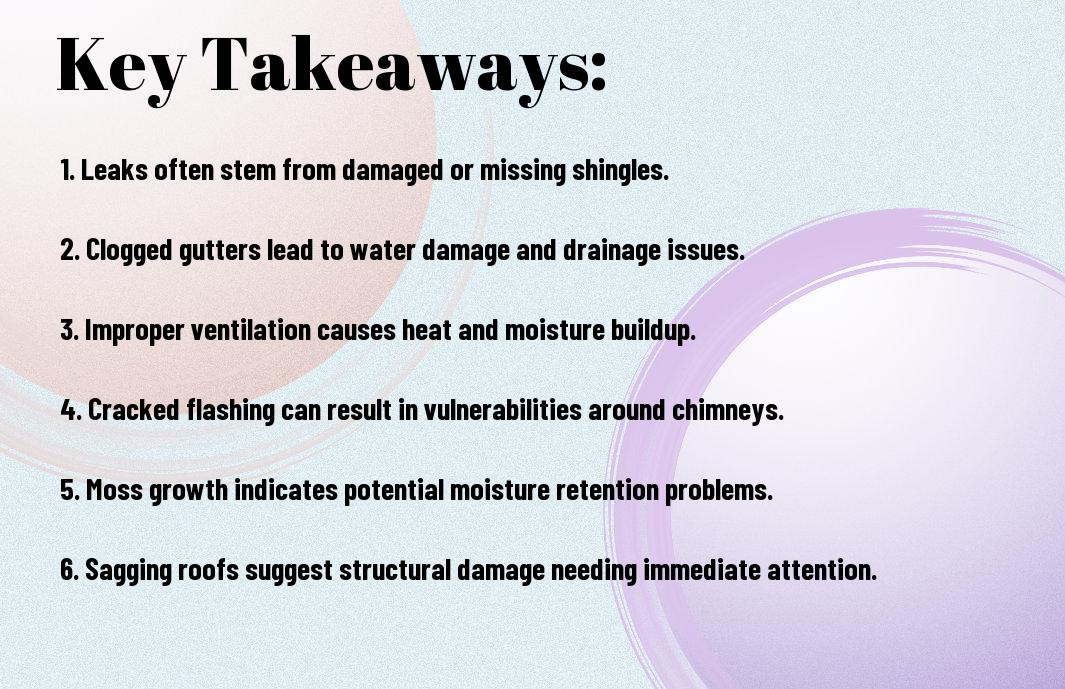Most homeowners may overlook the significance of regular roof inspections, but identifying issues early can save you time and money. During inspections, you might encounter common problems such as leaks, missing shingles, or drainage issues. Understanding these challenges and their solutions will help you maintain the integrity of your roof and safeguard your home. In this post, we will explore the most frequent roof issues found during inspections and provide you with practical solutions to address them effectively.
Key Takeaways:
- Regular inspections can identify common roof issues such as leaks, damaged shingles, and improper drainage before they escalate into larger problems.
- Solutions for roof issues vary; depending on the severity, options might include simple repairs, replacement of shingles, or installation of better drainage systems.
- Maintaining clear gutters and downspouts is vital for preventing water backup and ensuring the longevity of your roof.
Common Roof Issues
The roof is one of the most vital components of your home, yet it often faces various problems that can compromise its integrity. During inspections, you may encounter issues like leaks, damaged shingles, and improper ventilation. Identifying these problems early on can save you from costly repairs, ensuring your roof remains in optimal condition for years to come.
Leaks and Water Damage
Above all else, leaks and water damage are top concerns for homeowners. They often lead to significant structural issues if not addressed promptly. When water seeps through your roof, it can damage insulation and ceilings, while also promoting mold growth. Regular inspections can help you catch these leak sources early, allowing you to protect your home from further damage.
Missing or Damaged Shingles
Roof issues stemming from missing or damaged shingles can severely impact your home’s protection against the elements. These shingles are your first line of defense, and when they are compromised, it can expose your roof to leaks and decay. Regular checks for curling, cracking, or absent shingles will help you maintain the integrity of your roof.
Leaks from missing or damaged shingles can result in extensive damage to your home’s interior and structure. If you notice loose or absent shingles, it’s advisable to replace them immediately to prevent water infiltration. This repair is straightforward and can often be a DIY task, saving you money and ensuring your roof remains watertight during storms and heavy rains.
Structural Problems
There’s a range of structural issues that can undermine the integrity of your roof. From sagging beams to inadequate ventilation, these problems can lead to significant damage over time. Identifying and addressing these issues early during inspections can save you from costly repairs down the line.
Roof Sagging
Across many homes, roof sagging is a common issue caused by excessive weight or improper support. You may notice this problem through visible dips in the roofline or water pooling in certain areas. This condition requires immediate attention to prevent further structural damage.
Inadequate Ventilation
Around your roof, inadequate ventilation can cause serious problems such as moisture buildup and temperature inconsistencies. If your attic is poorly ventilated, it can lead to mold growth and damage to the roof structure over time.
Another important aspect to consider is that inadequate ventilation can also make your home less energy-efficient. When hot air gets trapped in your attic during the summer months, it forces your cooling system to work harder, leading to increased energy bills. Proper ventilation helps regulate temperature and allows moisture to escape, protecting your roof and ensuring a comfortable living environment.
Gutter and Drainage Issues
Keep your roof’s integrity intact by addressing gutter and drainage issues promptly. Poorly functioning gutters can lead to water damage, mold growth, and extensive roof repairs. Regular inspections can help you identify problems early and implement necessary maintenance to prolong the life of your roof.
Clogged Gutters
Clogged gutters can cause rainwater to overflow, leading to rot and leaks within your roof structure. To prevent this, you should regularly clean your gutters of leaves and debris, and consider installing guards to keep them clear.
Improper Drainage Solutions
Around your home, improper drainage can lead to water pooling near the foundation, which can subsequently affect your roof’s stability. Make sure your landscaping directs water away from your home, and inspect your drainage systems frequently to ensure they function as intended.
Another common issue linked to improper drainage solutions is the erosion of soil around your foundation. This can lead to settlement issues and leakage into your basement or crawl space. Ensure that downspouts are extended adequately to direct water away from the house, and consider using French drains or similar systems if you’re experiencing persistent issues. By addressing these considerations, you can protect your roof and foundation from costly damage.
Roof Material Deterioration
All roofing materials have a finite lifespan, and deterioration is often one of the most significant issues identified during inspections. Environmental factors, wear and tear, and other stressors can cause your roof to degrade over time, leading to potential leaks and other costly repairs. Addressing these issues early on can save you money and prolong the life of your roofing system.
Aging Roofing Materials
With time, your roofing materials will naturally age and become more susceptible to damages. Asphalt shingles, for example, may start to lose their granules, resulting in decreased effectiveness. When inspecting your roof, look for visible signs of wear, such as curling, cracking, or fading. Early detection can help you decide whether to repair or replace your roofing system before further damage occurs.
Impact of Weather Conditions
Above all, weather conditions can significantly affect the integrity of your roof. Extreme temperatures, heavy rains, and strong winds can accelerate the deterioration process, compromising your roof’s performance and longevity.
In addition, prolonged exposure to harsh weather conditions can lead to moisture build-up, creating a breeding ground for mold and mildew, which can weaken your roof structure further. Sun exposure can dry and crack materials, while freezing temperatures can cause expansion and contraction that may lead to fractures. Regular inspections, especially after severe weather events, can help you identify and address any issues that arise from these environmental stressors, ensuring your roof remains in good condition year-round.
Pest Infestation
To ensure the longevity of your roof, it’s vital to address pest infestations promptly. Common pests such as termites, squirrels, and rodents can cause significant damage by burrowing into roofing materials or nesting in your attic. These intruders not only compromise the structural integrity of your roof but can also lead to further complications, such as water leaks and mold growth.
Common Pests in Roofing
Below are some of the pests that frequently invade roofs: termites, which consume wood; squirrels, known for their gnawing habits; and rodents that create nests and enter through small openings. These pests can wreak havoc on your roofing system if left unchecked, making it important to identify them early.
Preventative Measures
Against these intrusions, maintaining your roof is key. Regularly inspect your roof for gaps or damage, and ensure proper ventilation is in place to minimize moisture buildup, which attracts pests. Additionally, consider installing screens over vents and chimneys to keep unwanted guests out.
Measures you can take include routine inspections and maintenance to identify potential entry points, sealing any cracks or gaps, and ensuring that your gutters are clean and free of debris. Keeping tree branches trimmed away from your roof can also deter pests, as it reduces access points. Ensuring proper ventilation not only helps control moisture but also makes your home less appealing to pests. With these proactive steps, you can significantly reduce the likelihood of pest infestations affecting your roof.
Inspection Process
After scheduling a roof inspection, you can expect a thorough evaluation of your roofing system. The inspector will assess various elements, including the roof’s materials, structure, and drainage system, ensuring that potential issues are identified early on. This proactive approach can save you money and extend the life of your roof.
What Inspectors Look For
At a roof inspection, inspectors focus on signs of wear and tear, such as missing shingles, sagging sections, and water damage. They also check flashings, gutters, and ventilation systems to ensure they are functioning properly. This detailed assessment helps identify issues that could lead to costly repairs if left unaddressed.
Frequency of Inspections
Process your roof inspections at least once a year, ideally in the spring and fall. This preventive measure will help you stay ahead of any potential issues and maintain the integrity of your roof. It’s especially important to inspect your roof after significant weather events, as they may cause hidden damage.
Also, you should consider increasing the frequency of inspections if you live in an area prone to severe weather or if your roof is older. Regular inspections can help you catch small problems before they escalate into larger issues, ultimately preserving your investment. By staying proactive, you can ensure that your roof remains in good condition and functions efficiently over time.
Final Words
As a reminder, understanding common roof issues that arise during inspections allows you to take proactive measures to protect your investment. From damaged shingles to improper drainage, being aware of these problems can help you resolve them quickly and effectively. Regular maintenance and addressing minor repairs early can prevent costly replacements down the line. By prioritizing your roof’s health, you ensure the longevity and safety of your home. Stay informed and take action as needed to keep your roof in optimal condition.
Q: What are some common roof issues identified during inspections?
A: During roof inspections, several common issues may be identified. These include missing or damaged shingles, leaks, sagging or uneven areas, and damaged flashing. Additionally, signs of water pooling, moss or algae growth, and worn-out gutters can also signal underlying problems that need addressing. Prompt identification and repair of these issues can prevent further damage and extend the lifespan of the roof.
Q: How can I prevent roof leaks from developing?
A: To prevent roof leaks, regular maintenance is key. This includes cleaning gutters to ensure proper water drainage, inspecting and replacing damaged shingles, and maintaining adequate flashing around chimneys and vents. It is also beneficial to perform seasonal inspections, especially after heavy storms or strong winds, to catch potential leaks before they become serious problems. Additionally, ensuring proper attic ventilation can help reduce moisture buildup that may lead to leaks.
Q: What solutions are available for repairing sagging roofs?
A: Sagging roofs can indicate structural problems, which require prompt attention. Solutions often involve reinforcing the roof’s support system, such as adding additional trusses or rafters, or repairing damaged beams. In some cases, replacing sections of the roof deck may be necessary to ensure stability. It’s advisable to consult with a roofing professional to assess the situation and recommend the most appropriate repair methods for the specific issue.






